Can a giant elastic band really sculpt an athletic-looking body? And if so, then how? If you’re new to band training, then that’s probably the question you’re dying to get the answer to. Well, this post gives a comprehensive explanation of why and how resistance bands work.
Exercise bands work by providing external resistance for exercises. As the resistance band stretches, it develops tension which increases the intensity of any given movement. As a result, they work similarly to free weights and they can be just as effective for building muscle and losing weight.
I’ve been using resistance bands (also known as exercise, stretch, booty, and workout bands) for over 3 years now, so I know they really do work.
Below, I’ll explain why resistance bands are so effective, how well they actually work compared to weights, and what exercises you can do with them.
Additionally, I’ll share real-life case studies and scientific research which supports the idea that bands actually work and aren’t just a gimmick!
Let’s dive straight in.
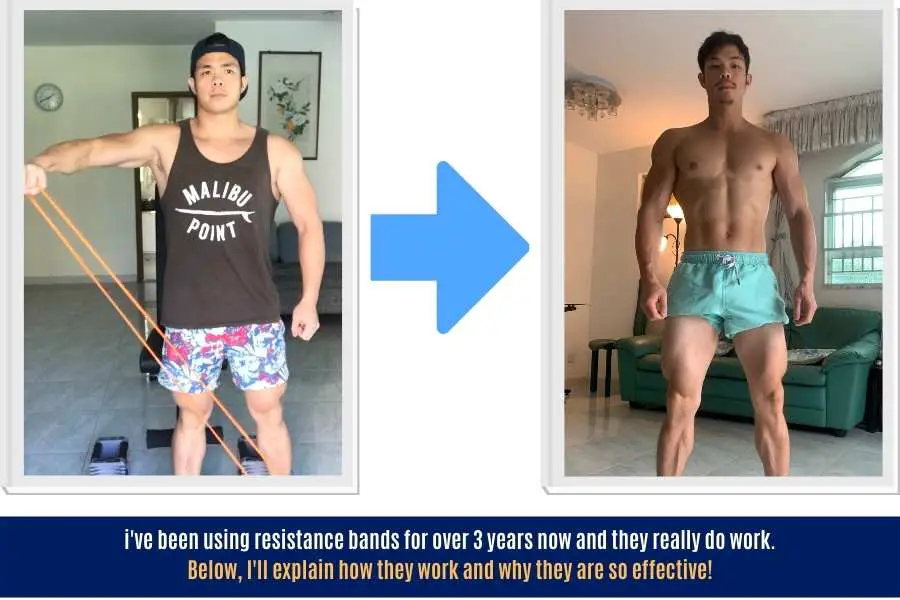
- The Resistance Bands Shown In This Post
- How Resistance Bands Work: Beginners Crash Course
- The Two Main Ways To Use Resistance Bands
- Why Resistance Bands Work So Well
- How Well Bands Actually Work Compared To Weights
- Case Studies Show Resistance Bands Really Do Work And Are Effective
- Do Bands Effectively Build Muscle And Burn Fat?
- What Muscles Resistance Can Bands Work
- How Resistance Bands Can Be Used For Pull-Ups
- Conclusion
The Resistance Bands Shown In This Post
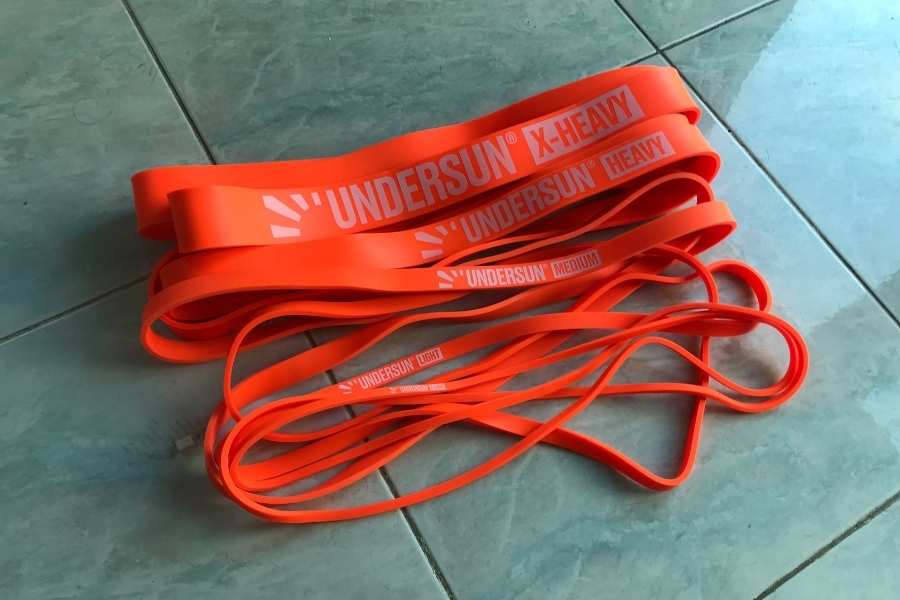
To demonstrate how resistance bands work, I’ve included several photos of myself using them in this post. They are the Undersun resistance bands and I highly recommend them. They’re slightly more expensive than their budget competitors, but I’ve gone through a lot of different models past and present (cheap and expensive) and these are by far the best I’ve used. The set comes with 5 different resistance levels and a lifetime guarantee. You can go to this post for the Undersun band pros and cons.
How Resistance Bands Work: Beginners Crash Course
Resistance bands work very well for training all of the major muscle groups, despite common doubts amongst beginners. In fact, band workouts are a popular way for novice and advanced lifters alike to build muscle and lose fat without having to use free weights.
Resistance is resistance at the end of the day.
Your muscles don’t differentiate between a resistance generated by a band or from a dumbbell, for example.
It can only see the amount of tension applied to it.
And as long as that resistance is enough to challenge your muscles, then they will adapt by getting stronger, no matter what type of equipment you use.
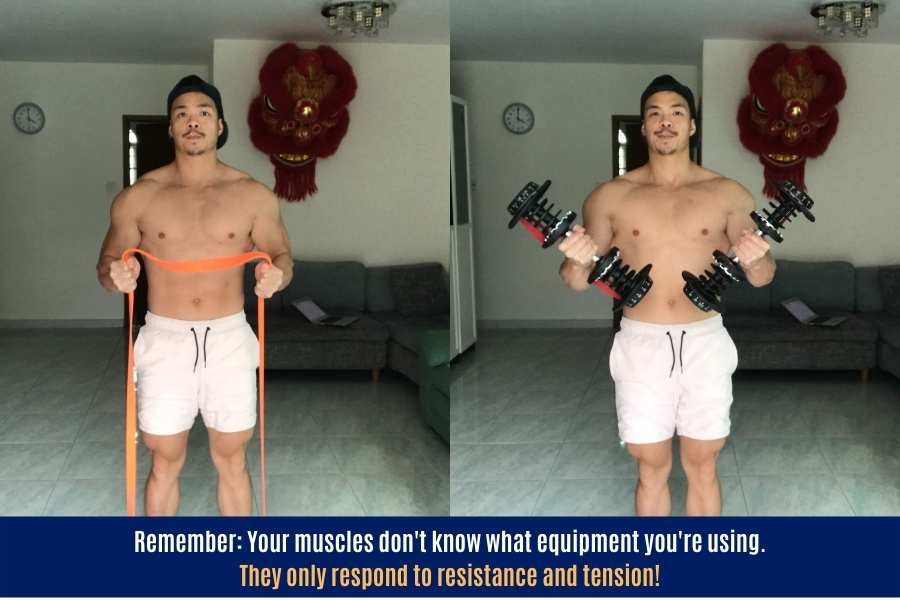
This brings me to my next point.
There are different methods to generate resistance for an effective workout; bands are just one of those methods.
One end of the band is typically attached to a stable object (like your foot, a lampost, or a door frame for example) and the other end is looped around different body parts (like your hand or foot) to target different muscle groups.
This allows you to then push or pull on the band, causing it to stretch and generate tension.
And the tension generated is what creates external resistance to the side opposite to the direction you’re pushing/pulling.
Ultimately, this works the target muscle and causes it to fatigue and get stronger.
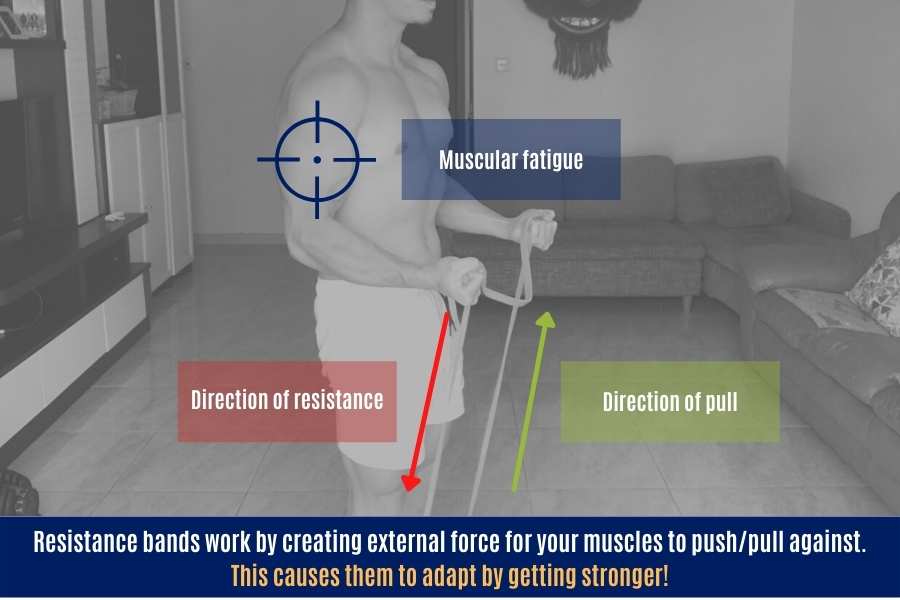
“You can loop [resistance bands] around your legs or arms, and they [come in a variety of different] shapes and sizes. Like weights, they have different resistance [levels] to make your workout easier or harder.”
Jen Skim, Personal Trainer
It’s also worth mentioning that bands come in a variety of designs, but they all work on the same basic principles described above.
The Two Main Ways To Use Resistance Bands
Resistance band exercises can be broadly categorized as:
- Un-anchored movements.
- Anchored movements.
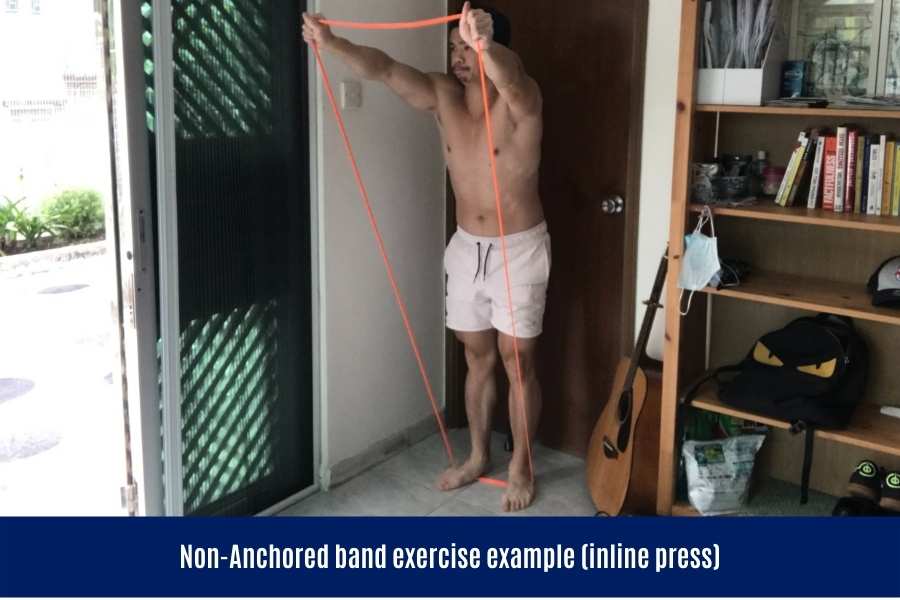
Un-anchored band exercises require you to hold the band at both ends or stand on them with your to create a fixed point to pull or push from.
These types of band exercises are extremely convenient to perform (they can be done anywhere).
However, you’re more limited in regards to the angles you can generate to isolate different regions of a muscle group, compared to anchored movements.
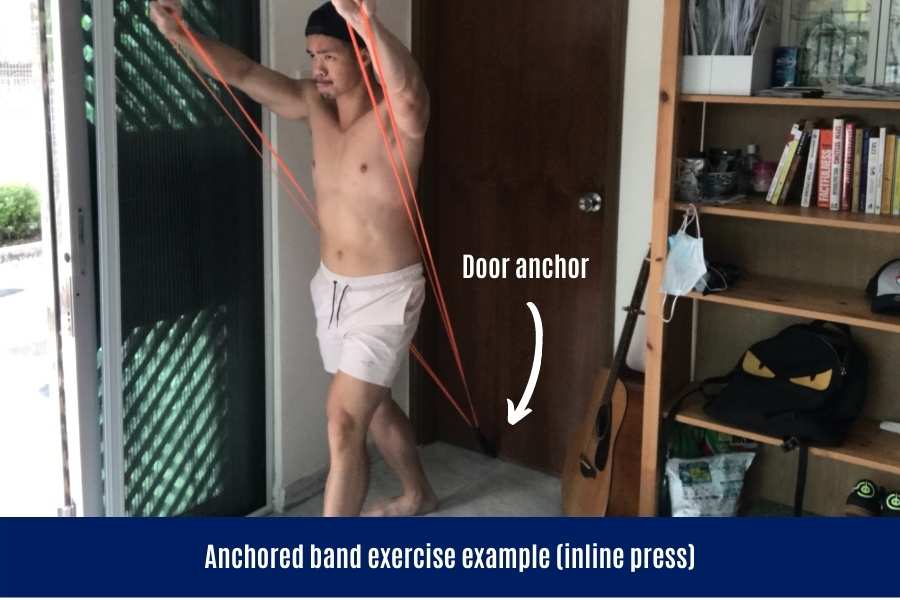
Anchored band exercises require a separate anchor to attach your bands onto. This commonly takes one of two forms:
- Door anchors like the Boss doorway anchor are cheap and don’t require you to drill into your walls (they slide through your door gap). But they don’t handle as much tension as a wall-mounted anchor. This makes them ideal for beginners and intermediates.
- Wall-mounted anchors like the Ouuo wall anchor are slightly more expensive and need to be drilled into your walls. But they can take much more tension compared to a door anchor. This makes them great for advanced lifters who need the heaviest resistances to build muscle.

Regardless of type, an anchor functions to:
- Increase exercise variety,
- Open new angles to isolate different regions of the same muscle group.
- Allow you to increase exercise intensity by creating a greater band stretch.
For example, an anchored incline press allows you to optimize the angle for targeting the upper pecs as well as allow you to stretch the band more than you could by doing an un-anchored incline press.
A good set of bands like the Undersun resistance bands already come bundled with a doorway anchor so you don’t have to buy them separately!
They are the bands you see me using in the photos above.
Why Resistance Bands Work So Well
Resistance bands work so well because of their unique tension profile. Unlike free weights and machines, a band increases tension and resistance as it goes through the range of motion and stretches. This makes them extremely effective for activating a given target muscle.
Let’s use a dumbbell vs resistance band bicep curl to illustrate this point.
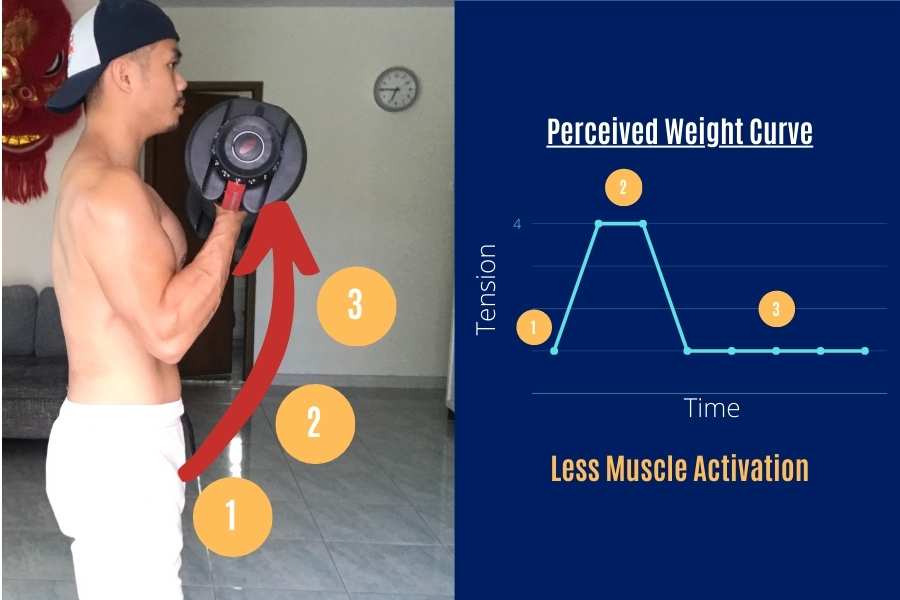
In the traditional dumbbell curl, the perceived weight curve changes as you go through the range of movement (ROM).
How?
The dumbbell feels lighter at the bottom, heavier during the middle, and lighter again at the top.
Without going too deep into the biomechanics, this is due to gravity acting on the position of the dumbbell in relation to your forearm and elbows; the further forward the dumbbell is in relation to your elbow, the heavier it feels.
This isn’t too dissimilar to how it’s much harder to hold a stack of books with an outstretched arm, compared to holding the same stack close to the chest.
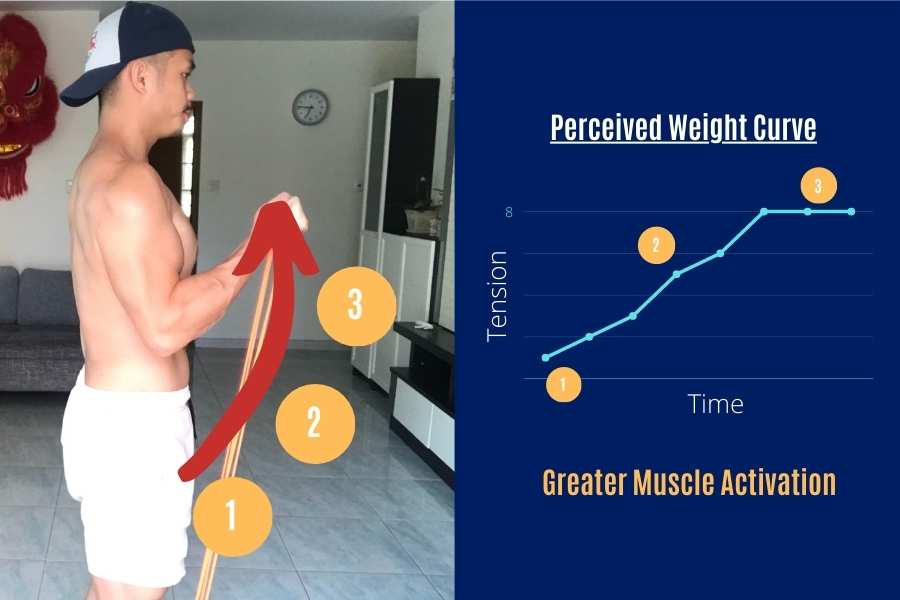
In the resistance band curl, the perceived weight curve starts low and increases as you go through the range of movement.
In other words, it feels progressively heavier as you curl the band towards the shoulders and the band stretches.
This means bands activate your muscles to a much greater extent compared to free weights.
For example, studies like this one from the Journal of Medicine and Science in Sport and Exercise have reported a greater quadriceps activity during the upper portion of a resistance band leg press vs a machine leg press.
This unique tension profile makes them a favorite with physiotherapists for post-injury rehabilitation, or for the elderly, since the individual can push/pull on a band within their own constraints without having to lift a heavy dumbbell for example.
How Well Bands Actually Work Compared To Weights
Numerous studies have shown that resistance bands work just as well as free weights. It has been demonstrated that band workouts can elicit a similar degree of muscle activation as free weight training. Therefore bands are just as good as weights for building muscle and strength.
Check out these scientific studies which show resistance bands can work just as well as weights:
- This 2019 meta-analysis showed that resistance bands work just as well as free weights for gaining muscle and strength across a variety of exercises and muscle groups (lower and upper body). Men and women at different fitness levels were studied from all around the world. The study suggested that it doesn’t matter who you are, resistance bands work just as well as weights!
- This 2011 study found that adding resistance bands to a barbell bench press program elicited 30% more strength gains compared to using a barbell alone. This suggests that using a combination of bands and weights is the best for muscle and strength development.
- Another 2014 study replaced split 25 women into two groups. Group 1 squatted a plate-loaded barbell and Group 2 squatted an empty barbell with resistance bands looped and anchored to the floor on both sides. They found that the banded-barbell elicited a similar muscle activation as the plated-barbell. In other words, the resistance bands worked just as well as the weights.
My advice?
Combine a good set of resistance bands like these Undersun bands with weights like these dumbbells for the best results.
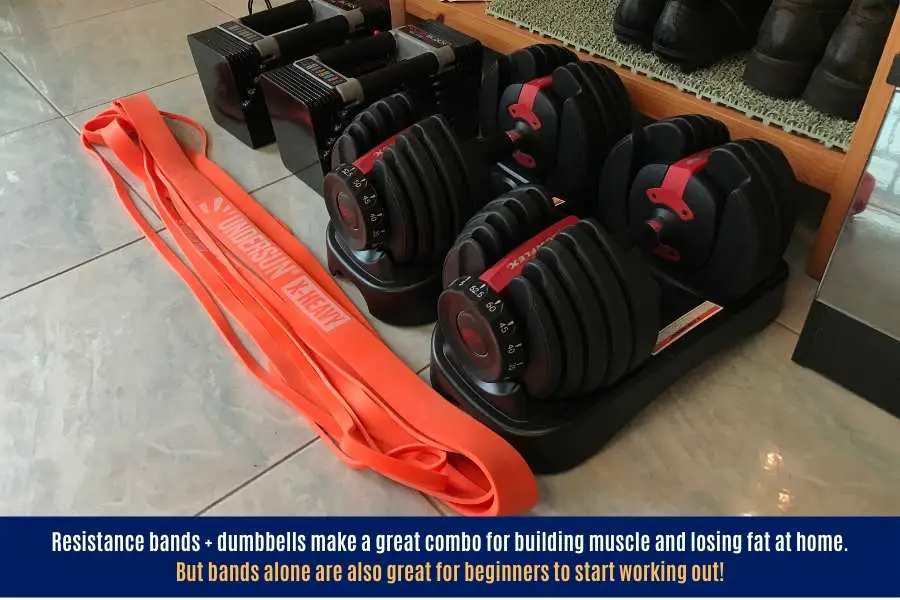
This subjects your muscles to different training stimuli for maximal strength and muscle gains and the biggest fat-burning effect.
And if home dumbbells aren’t an option, then bands alone are a great investment and can be a great way to start training!
Case Studies Show Resistance Bands Really Do Work And Are Effective
Resistance band training really does work. There are numerous online case studies of men and women building muscle, gaining strength, losing fat, and improving their body composition by undertaking a resistance band training program. This has also been supported by scientific studies.
Here are some before and after case studies to show you that resistance bands really are effective:

- Me! I’ve been using my Undersun bands, in conjunction with dumbbells and barbells, for over 3 years now. Resistance band workouts have helped me to gain muscle, get ripped, and build a V-taper body, get broader shoulders. I’ve also used band workouts to broaden my shoulders, lose fat to reveal my abs, as well as tone my arms and chest.
Ashboy from Youtube. He underwent a 30-day resistance band workout program. You can see he effectively lost belly fat, reduced overall body fat percentage, increased muscle tone, and gained lean muscle mass in the whole body. His V-shaped taper began to show and he developed an overall more ripped and shredded appearance.
- Jake Rak from Twitter. He undertook a 2-month resistance band workout regime. He was already in great shape before, but you can see he was still able to use bands to gain muscle definition, lose overall body fat, build broader shoulders, and develop a wider chest. Result? A lean and ripped body!

- Dap713 from Reddit. He took on resistance band training during his 2 year travels to build a strong and sculpted physique that had low body fat and great definition. You can see his prominent abs, arms, and shoulders as a result of the resistance band workouts.

- Erin McComb Pro bodybuilder. She’s a strong advocator for using bands and especially likes using them to work her glutes and lower body!
Do Bands Effectively Build Muscle And Burn Fat?
Resistance bands are an excellent way to build muscle or burn fat. This makes them great for gaining lean mass as well as for losing weight. However, it is also important to follow a nutrition plan that is appropriate for the desired training goal.
Generally speaking:
- Building muscle and lean mass gains requires a calorie surplus. A mild 5-10% daily caloric surplus ensures your body has the fuel required for hypertrophy (muscle growth). A muscular and jacked physique!
- Burning fat and weight loss require a calorie deficit. A mild 5-10% daily caloric deficit ensures your body burns belly fat slowly and sustainably. Result? A ripped and shredded physique!
Regardless of your goal, a high daily protein intake is recommended (at least 0.8g per lb of body weight).
It’s also important to note that resistance bands come in a variety of resistance levels that are suitable for different goals, as follows:
| Resistance Band Classification | Typical Resistance Provided | Best Used For: |
|---|---|---|
| Extra light | 10-15lbs | Burning fat and toning arms |
| Light | 15-25lbs | Burning Fat and toning arms |
| Medium | 20-60lbs | Building muscle or weight loss |
| Heavy | 25-80lbs | Building muscle |
| Extra Heavy | 30-120lbs | Building muscle |
Always use a resistance level that challenges you for whatever exercise you’re performing.
You can usually tell when the last few reps in a set become difficult to complete (burning arms and general fatigue is always a good sign!)
Doing this ensures you’re gaining the full benefits of resistance band training.
Single vs Set Of Bands?
I always recommend buying a set of bands rather than singles and here’s why:
- A set with different resistance levels means you can effectively work small AND large muscle groups (e.g. the biceps and pecs respectively).
- You’ll naturally become stronger over time. It’s important to increase resistance to keep your muscles challenged and continue reaping the benefits of your band workouts.
- Resistance bands are generally durable. But just like any other product, they can wear out over time. Having a set of bands gives you a degree of redundancy when a band breaks and prevents your training from being interrupted.
The Undersun resistance bands that I use in this post come in a set of 5 bands (extra light to heavy).
They’re sufficient for beginners and advanced trainers alike.
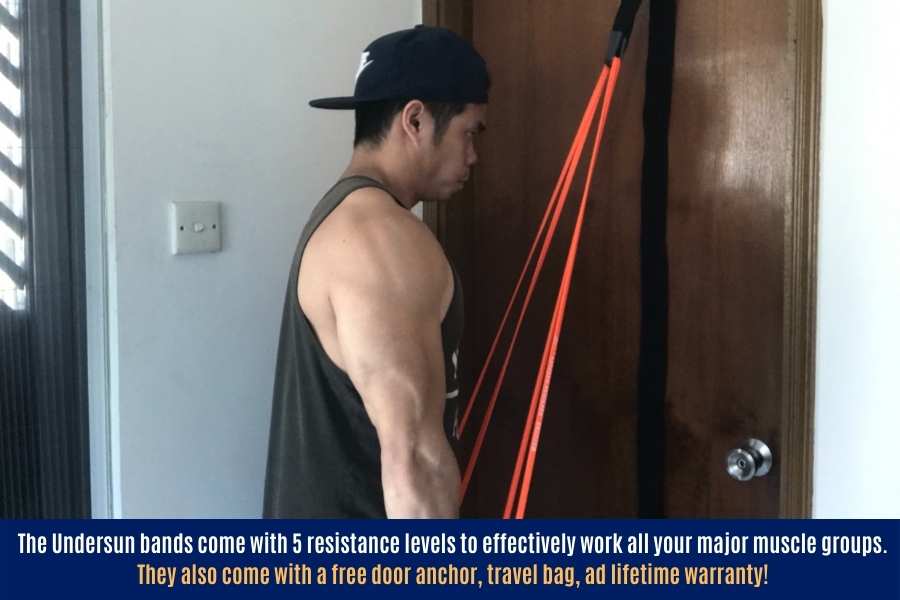
They also come with a lifetime warranty.
In short, they should last you forever (mine are still going strong after 3 years)!
What Muscles Resistance Can Bands Work
Resistance bands can work all the major muscle groups in the body. This includes the muscles in the arms, shoulders, back, chest, abs, and legs. By changing the angle and adjusting the anchor point of the resistance band exercise, they can be used to target different body regions.
The table below gives you a better idea of what muscles you can work using resistance bands:
| Resistance Band Exercise | Muscles Worked | Body Region |
|---|---|---|
| Bicep curl | Biceps | Arms |
| Tricep extension | Triceps | Arms |
| Shoulder press | Anterior/lateral/posterior deltoids, triceps | Shoulders |
| Lateral raise | Medial deltoids | Side shoulders |
| Front raise | Anterior deltoids | Front shoulders |
| Banded push-up | Pectorals, triceps, deltoids | Chest, arms, and shoulders |
| Flat and incline press | Pectorals, triceps, deltoids | Chest, arms, and shoulders |
| Chest flyes | Pectorals | Chest |
| Rows | Trapezius, rhomboids, latissimus dorsi, biceps | Back and arms |
| Reverse flyes | Trapezius, rhomboids, | Back |
| Band-assisted pull-ups | Trapezius, rhomboids, latissimus dorsi, biceps, core | Back, arms, abs |
| Crunches | Abdominals, obliques | Abs |
| Side-bends | Obliques | Abs |
| Woodchoppers | Abdominals, obliques | Abs |
| Squats | Quadriceps, hamstrings, calves, glutes, core | Legs and abs |
| Deadlifts | Total body | Whole-body |
| Lunges | Quadriceps, hamstrings, calves, glutes, core | Legs and abs |
You can see different resistance band exercises work different muscles and body parts.
An effective workout program should cover all bases.
In other words, try to train all your major muscle groups equally.

Additionally, resistance bands are great for working your stabilizer muscles.
Stabilizers are the small muscles that surround your primary target muscle. They serve to stabilize a joint and keep the bands aligned during an exercise.
And stronger stabilizers lead to increased strength and the ability to lift heavier loads.
Consequently, you’ll be able to build more muscle and burn more fat!
How Resistance Bands Can Be Used For Pull-Ups
Resistance bands can be used to assist pull-ups for someone who cannot do one unassisted. This typically involves looping one end of the band across the bar and the other end around the buttocks of the individual. As the band stretches, it helps to lift the person towards the bar.
Here’s what that looks like:
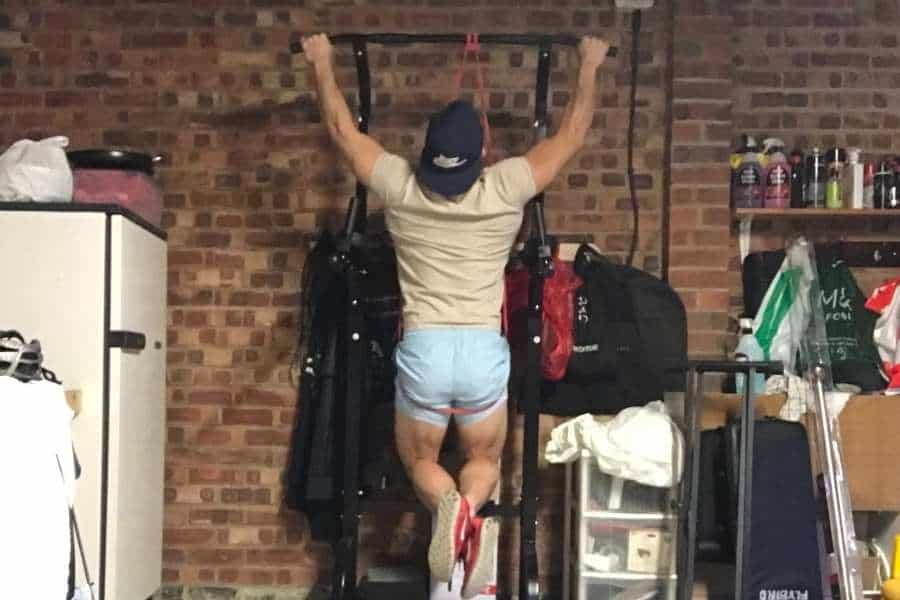
Other than the muscle-building and fat-loss benefits already discussed, another great way to use resistance bands is to assist with pull-ups.
Pull-ups are an awesome exercise for building upper body muscle as well as burning a lot of calories in a short amount of time.
The problem?
Most of us struggle to do one without months of training! And some of us simply give up before getting there.
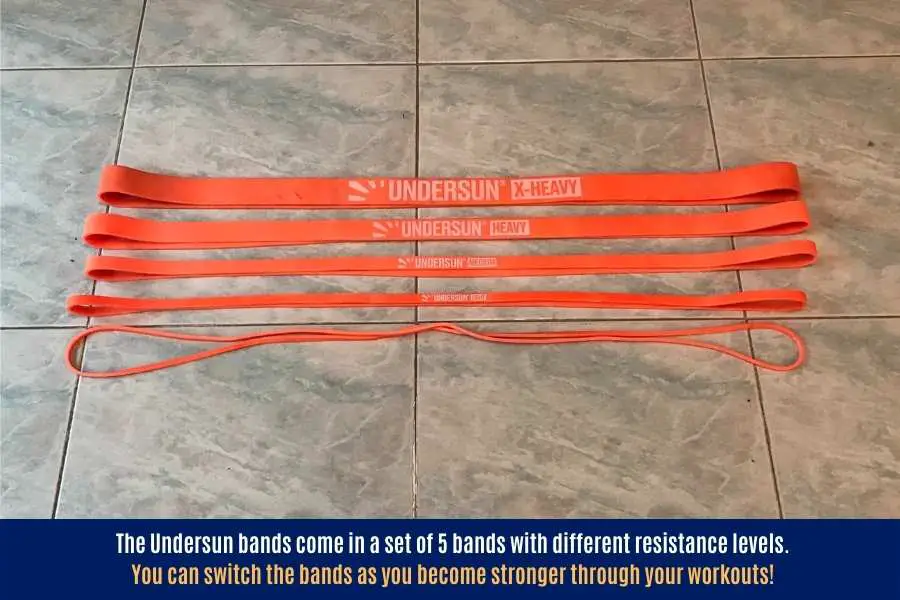
Well, the great thing with a good set of bands like the Undersuns is that they’re long enough to wrap around the bar AND your butt.
This means they give you more assistance the lower you hang down.
If you continue working on assisted pull-ups and decrease the assistance by using a lighter band every 1-3 weeks, you should be able to do unassisted pull-ups within a couple of months!
Conclusion
I’ve explained how resistance bands work, why they work so well, and how well they work compared to free weights.
At the end of the day, training with resistance bands is just as effective as using weights as long as you push yourself.
If you do, then you can expect to build muscle, lose fat, and generally improve your body composition by using the resistance band exercises I shared in this post!
Just make sure you’re following a good nutrition plan on the side.
I’ve also shared some before and after case studies and provided scientific evidence to show you that resistance bands really are effective.
Have you got any questions about how resistance bands work?
Feel free to send me a message if you have any questions! You can find my details on the “contact us” page.
You may also be interested in the downloadable Kalibre Blueprint PDF which details exactly how I gained 40lbs of lean muscle (it’s 100% free!). It details the exact exercises and nutrition (with printable worksheets) I used to go from skinny to ripped!
Thanks for reading guys!
Peace Out,
Kal
(Biochemistry BSc, Biomedical Sciences MSc, Ex-Skinny Guy)


